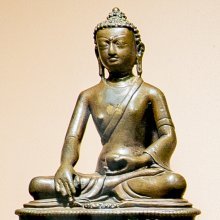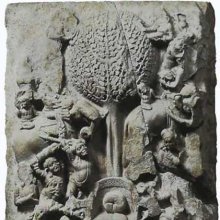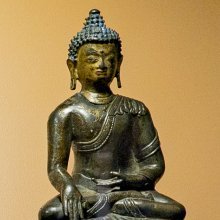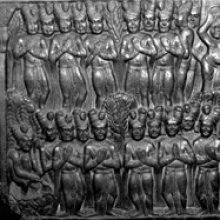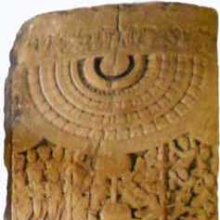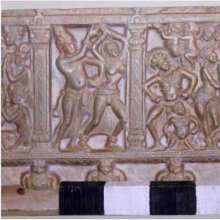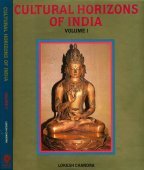Mara, Māra, Marā: 34 definitions
Introduction:
Mara means something in Buddhism, Pali, Hinduism, Sanskrit, Jainism, Prakrit, the history of ancient India, Marathi, Hindi, biology, Tamil. If you want to know the exact meaning, history, etymology or English translation of this term then check out the descriptions on this page. Add your comment or reference to a book if you want to contribute to this summary article.
Alternative spellings of this word include Maar.
Images (photo gallery)
(+21 more images available)
In Hinduism
Purana and Itihasa (epic history)
Source: archive.org: Shiva Purana - English TranslationMāra (मार) refers to a group of deities created by Brahmā and tasked with serving Kāma (god of love), according to the Śivapurāṇa 2.2.9. Accordingly:—“[...] On hearing the words of Kāma—“I am incompetent to enchant Śiva”,O sage, I heaved a deep sigh due to extreme sorrow. The gusts of wind generated by my deep sighs were of various forms and very violent. They were tremulous and terrible and appeared to have shaking tongues (of flames). They played on different musical instruments, drums etc. of terrible nature and of loud sound. The groups of beings [viz., Māras] issuing forth from my deep breaths stood in front of me, Brahmā shouting ‘Kill!—Cut!’.”
Even as they were born they shouted “Māraya” “Kill”, very frequently. Hence let their names be “Māras”. These groups of beings will hinder the activities of all creatures, O Kāma, except Your Worship as they are engaged in various avocations of love. O Kāma, their chief occupation will be to follow you. There is no doubt that they will assist you always. Wherever you go for fulfilling your duty, whenever it be, they will invariably follow you and render assistance. They will create confusion in the minds of those who fall as victims to your weapons. They will hinder wise people in the path of knowledge in all possible ways.”.

The Purana (पुराण, purāṇas) refers to Sanskrit literature preserving ancient India’s vast cultural history, including historical legends, religious ceremonies, various arts and sciences. The eighteen mahapuranas total over 400,000 shlokas (metrical couplets) and date to at least several centuries BCE.
Jyotisha (astronomy and astrology)
Source: Wisdom Library: Brihat Samhita by VarahamihiraMāra (मार) refers to “death”, according to the Bṛhatsaṃhitā (chapter 5), an encyclopedic Sanskrit work written by Varāhamihira mainly focusing on the science of ancient Indian astronomy astronomy (Jyotiṣa).—Accordingly, “[...] Commencing from the time of creation, ... Varuṇa is the lord over the new and full moon periods of the fifth six months; Agni over those of the sixth six months and Yama over those of the seventh six months; [...] If Varuṇa should be the lord, princes will suffer; the rest will be happy and crops will flourish. If Agni should be the lord, there will be good crops, and there will also be health, freedom from fear and abundance of water. If Yama should be the lord, there will be drought, famine, and total blight of crops; in the next parva mankind will be afflicted with misery, hunger, death [i.e., māra] and drought”.

Jyotisha (ज्योतिष, jyotiṣa or jyotish) refers to ‘astronomy’ or “Vedic astrology” and represents the fifth of the six Vedangas (additional sciences to be studied along with the Vedas). Jyotisha concerns itself with the study and prediction of the movements of celestial bodies, in order to calculate the auspicious time for rituals and ceremonies.
In Buddhism
Theravada (major branch of Buddhism)
Source: Access to Insight: A Glossary of Pali and Buddhist TermsThe personification of evil and temptation.Source: Pali Kanon: Pali Proper NamesGenerally regarded as the personification of Death, the Evil One, the Tempter (the Buddhist counterpart of the Devil or Principle of Destruction). The legends concerning Mara are, in the books, very involved and defy any attempts at unravelling them. In the latest accounts, mention is made of five Maras
Khandha Mara, Kilesa Mara, Abhisankhara Mara, Maccu Mara and Devaputta Maraas shown in the following quotations: pancannam pi Maranam vijayato jino (ThagA.ii.16); sabbamittehi khandha kilesa bhisankharamaccudeva puttasankhate, sabbapaccatthike (ThagA.ii.46); sankhepato va pancakilesa khandhabhi sankhara devaputta maccumare abhanji, tasma . . . bhagava ti vuccati (Vsm.211).
Elsewhere, however, Mara is spoken of as one, three, or four. Where Mara is one, the reference is generally either to the kilesas or to Death. Thus: Marenati kilesamarena (ItvA.197); Marassa visaye ti kilesamarassa visaye (ThagA.ii.70); jetvana maccuno senam vimokkhena anavaran ti lokattayabhibyapanato diyaddhasahassadi vibhagato ca vipulatta annehi avaritum patisedhetum asakkuneyyatta ca maccuno, Marassa, senam vimokkhena ariyamaggena jetva (ItvA.198); Marasena ti ettha satte anatthe niyojento maretiti Maro (UdA.325); nihato Maro bodhimule ti vihato samucchinno kilesamaro bodhirukkhamule (Netti Cty. 235); vasam Marassa gacchatiti kilesamarassa ca sattamarassa (?) ca vasam gacchi (Netti, p. 86); tato sukhmnataram Marabandhanan ti kilesabandhanam pan etam tato sukhumataram (SA.iii.82); Maro maro ti maranam pucchati, maradhammo ti maranadhammo (SA.ii.246).
It is evidently with this same significance that the term Mara, in the older books, is applied to the whole of the worldly existence, the five khandhas, or the realm of rebirth, as opposed to Nibbana. Thus Mara is defined at CNid. (No. 506) as kammabhisankharavasena patisandhiko kandhamaro dhatumaro, ayatanamaro. And again: Maro Maro ti bhante vuccati katamo nu kho bhante Maro ti? Rupam kho, Radha, Maro, vedanamaro, sannamaro, sankharamaro vinnanam Maro (S.iii.195); yo kho Radha Maro tatra chando pahatabbo. Ko ca Radha Maro? Rupam kho Radha Maro . . . pe . . . vedanamaro. Tatra kho Radha chando pahatabbo (S.iii.198); sa upadiyamano kho bhikku baddho Marassa, anupadiyamano mutto papimato (S.iii.74); evam sukhumam kho bhikkhave, Vepacittibandhanam; tato sukhumataram marabandhanam; mannamano kho bhikkhave baddho Marassa, amannamano mutto papimato (S.iv.202); labhati Maro otaram, labhati Maro arammanam (S.iv.85); santi bhikkhave cakkhuvinneyyarupa ... pe . . . tan ce bhikkhu abhinandati . . . pe . . . ayam vuccati bhikkhave bhikkhu avasagato Marassa, Marassa vasam, gato (S.iv.91); dhunatha maccuno senam nalagaram va kunjaro ti pannindriyassa padathanam (Netti, p. 40);
Source: Dhamma Dana: Pali English GlossaryM / N (Enemy).
Source: Pali Kanon: Manual of Buddhist Terms and Doctrines(lit. 'the killer'), is the Buddhist 'Tempter-figure. He is often called 'Māra the Evil One' (pāpimā māro) or Namuci (lit. 'the non-liberator', i.e. the opponent of liberation). He appears in the texts both as a real person (i.e. as a deity) and as personification of evil and passions, of the totality of worldly existence, and of death. Later Pāli literature often speaks of a 'fivefold Māra' (pañca-māra): 1. M. as a deity (devaputta-māra), 2. the M. of defilements (kilesa-m.), 3. the M. of the aggregates (khandha-m.), 4. the M. of the karma-formations (kamma-m.), and 5. Māra as death (maccu-m.).
As a real person, M. is regarded as the deity ruling over the highest heaven of the sensuous sphere (kāmāvacara), that of the paranimmitavasavatti-devas, the 'deities wielding power over the creations of others' (Com. to M. 1). According to tradition, when the Bodhisatta was seated under the Bodhi-tree, Māra tried in vain to obstruct his attainment of Enlightenment, first by frightening him through his hosts of demons, etc., and then by his 3 daughters' allurements. This episode is called 'Māra's war' (māra-yuddha). For 7 years M. had followed the Buddha, looking for any weakness in him; that is, 6 years before the Enlightenment and one year after it (Sn. v. 446). He also tried to induce the Buddha to pass away into Parinibbāna without proclaiming the Dhamma, and also when the time for the Buddha's Parinibbāna had come, he urged him on. But the Buddha acted on his own insight in both cases. See D. 16.
For (3) M. as the aggregates, s. S. XXIII, 1, 11, 12, 23. See Padhāna Sutta (Sn. v. 425ff.); Māra Samyutta (S. IV).
Theravāda is a major branch of Buddhism having the the Pali canon (tipitaka) as their canonical literature, which includes the vinaya-pitaka (monastic rules), the sutta-pitaka (Buddhist sermons) and the abhidhamma-pitaka (philosophy and psychology).
Mahayana (major branch of Buddhism)
Source: Wisdom Library: Maha Prajnaparamita Sastra1) Māra (मार) refers to “the King of destruction of good works” according to the 2nd century Mahāprajñāpāramitāśāstra chapter X. Accordingly, the Bodhisattvas (accompanying the Buddha at Rājagṛha on the Gṛdhrakūṭaparvata) have passed beyond the works of Māra.
There are four kinds of māras:
- the affliction-māra (kleśamāra),
- the aggregate-māra (skandhamāra),
- the death-māra (mṛtyumāra),
- the son-of-god-māra (devaputramāra), chief of the Parinirmitavaśavartin gods.
By attaining the state of Bodhisattva, these Bodhisattvas have destroyed the kleśamāra; by acquiring the dharmakāya, they have destroyed the skandhamāra; by being always one-pointed (ekacitta), by not adhering to any (heavenly) sphere and by entering into the immoveable concentrations (acalasamādhi), they have destroyed the Paranirmitavaśavartin devaputramāra. This is why it is said that they have passed beyond the works of Māra.
Why is he called Māra? He is called Māra because he carries off the āyuṣmat and because he destroys the good root of the dharmas of the Path and of the qualities (guṇa).The heretics (tīrthika) call him Yu tchou (Kāmādhipati), Houa tsien (Kusumāyudha) or also Wou tsien (Pañcāyudha). In the Buddhist texts, he is called Māra because he destroys all good works.
2) Māra (मार) is one of the three great leaders among the gods according to the 2nd century Mahāprajñāpāramitāśāstra (chapter XV). Accordingly, “King Māra is the leader of six classes of gods of the world of desire or kāmadhātu: (Caturmahārājika, Trayastriṃśa, Yāma, Tuṣita, Nirmāṇarati and Paranirmitavaśavartin)”.
Also, “King Māra constantly comes to bother the Buddha and he is leader of the whole world of desire (kāmādhātu); the Yāma, Tuṣita and Nirmāṇarati gods all depend on him”.
Source: academia.edu: A Study and Translation of the GaganagañjaparipṛcchāMāra (मार) (Cf. Caturmāra) refers to the “evil ones”, according to the Gaganagañjaparipṛcchā: the eighth chapter of the Mahāsaṃnipāta (a collection of Mahāyāna Buddhist Sūtras).—Accordingly, “Then, the Lord went on to speak these verses: ‘(37) They give the whole of their possessions for the sake of the purification of vices (kleśa), and decide to establish the word of the Victorious One (jina). None of the Evil Ones (māra) can get at them, and they, having understood in such a way, give away everything (sarvatyāga). [...]’”.

Mahayana (महायान, mahāyāna) is a major branch of Buddhism focusing on the path of a Bodhisattva (spiritual aspirants/ enlightened beings). Extant literature is vast and primarely composed in the Sanskrit language. There are many sūtras of which some of the earliest are the various Prajñāpāramitā sūtras.
General definition (in Buddhism)
Source: Wisdom Library: Dharma-samgrahaMāra (मार) refers to the “four destroyers” as defined in the Dharma-saṃgraha (section 80):
- skandha-māra (the components destroyer),
- kleśa-māra (the defilements destroyer),
- devaputra-māra (the destroyer-god Māra),
- mṛtyu-māra (death as destroyer).
The Dharma-samgraha (Dharmasangraha) is an extensive glossary of Buddhist technical terms in Sanskrit (e.g., māra). The work is attributed to Nagarguna who lived around the 2nd century A.D.
Source: Wisdom Library: BuddhismMara:—This is the negative force present in all of us, which must be overcome if we are to advance in spiritual practice.
Source: Buddhist Door: GlossaryLiterally, "murderer". The Evil One who "takes" away the wisdom life of all living beings.Source: Shambala Publications: GeneralMāra Skt., Pali, lit., “murder, destruction”; although actually the embodiment of death, Māra symbolizes in Buddhism the passions that overwhelm human beings as well as everything that hinders the arising of the wholesome roots and progress on the path of enlightenment.
Māra is the lord of the sixth heaven of the desire realm and is often depicted with a hundred arms, riding on an elephant.
Source: Institute of Buddhist Studies: Buddhist Forum, Volume 4 (buddhism)Māra (मार).—The personification of all such saṃsāric, or more emphatically, anti-nirvāṇic temptations is Māra (= Mṛtyu = Death = Yama). In the Saṃyutta-nikāya, Māra in the guise of a deity comes to the Buddha and says: “He who hates austerity and does not like to stay alone, who is addicted to beautiful forms and wishes to go to the heavenly realms, is competent to give advice regarding the attainment of the next world”.
Māra is shown repeatedly to have confidence in his own position as a promoter of the pitṛyāna. The Buddha’s primary adversary is thus not Ignorance nor Desire nor Aversion as one might expect. Death fulfils this role—but Life, as the other side of the coin, would be just as good a name for a being encouraging transmigration and discouraging nirvāṇa.
In Jainism
General definition (in Jainism)
Source: SOAS Research Online: Prekṣā meditation: History and MethodsMara (मर) refers to “mortal”; as opposed to Amara—“immortal” which refers to one of the 46 qualities of the soul to be meditated on in the “Practice of Meditation on Liberated Souls (Siddhas)”, according to Jain texts like Ācārāṅga (5.6.123-140), Ṣaṭkhaṇḍāgama (13.5.4.31) and Samayasāra (1.49).—The pure soul can be recognised by meditation on its true nature, represented by the liberated souls of the Siddhas. [...] The qualities of the soul to be meditated on as truly mine are: [e.g., My soul is immortal (a-mara)] [...] The meditation on such extended fourty-five qualities of the pure soul presents the niśacaya-naya, which is aligned with Kundakunda’s approach.

Jainism is an Indian religion of Dharma whose doctrine revolves around harmlessness (ahimsa) towards every living being. The two major branches (Digambara and Svetambara) of Jainism stimulate self-control (or, shramana, ‘self-reliance’) and spiritual development through a path of peace for the soul to progess to the ultimate goal.
India history and geography
Source: Cologne Digital Sanskrit Dictionaries: Indian Epigraphical GlossaryMara.—(EI 14), name of a measure. Note: mara is defined in the “Indian epigraphical glossary” as it can be found on ancient inscriptions commonly written in Sanskrit, Prakrit or Dravidian languages.

The history of India traces the identification of countries, villages, towns and other regions of India, as well as mythology, zoology, royal dynasties, rulers, tribes, local festivities and traditions and regional languages. Ancient India enjoyed religious freedom and encourages the path of Dharma, a concept common to Buddhism, Hinduism, and Jainism.
Biology (plants and animals)
Source: Google Books: CRC World Dictionary (Regional names)1) Mara in India is the name of a plant defined with Albizia lebbeck in various botanical sources. This page contains potential references in Ayurveda, modern medicine, and other folk traditions or local practices It has the synonym Pithecellobium splitgerberianum Miq. (among others).
2) Mara is also identified with Albizia saman It has the synonym Mimosa pubifera Poir. (etc.).
3) Mara is also identified with Baccaurea courtallensis It has the synonym Pierardia macrostachya Wight & Arn. (etc.).
4) Mara is also identified with Barringtonia racemosa It has the synonym Butonica terrestris Miers (etc.).
5) Mara is also identified with Calophyllum inophyllum It has the synonym Balsamaria inophyllum (L.) Loureiro (etc.).
6) Mara is also identified with Ficus tinctoria It has the synonym Ficus gibbosa var. rigida Miq. (etc.).
7) Mara in Nepal is also identified with Aster diplostephioides It has the synonym Aster diplostephioides Benth. & Hook.f. (etc.).
8) Mara in South America is also identified with Cedrelinga cateniformis It has the synonym Pithecellobium catenaeformis (Ducke) Cardenas (etc.).
9) Mara in Sri Lanka is also identified with Falcataria moluccana It has the synonym Adenanthera falcatoria L. (etc.).
10) Mara in Upper Volta is also identified with Excoecaria grahamii It has the synonym Sapium grahamii (Stapf) Prain (etc.).
Example references for further research on medicinal uses or toxicity (see latin names for full list):
· Prodromus Systematis Naturalis Regni Vegetabilis (DC.) (1866)
· Natural history (1897)
· Flora of Tropical Africa (1906)
· Bioresour. Technol. (2037)
· Annales Museum Botanicum Lugduno-Batavi (1867)
· Characteres Generum Plantarum (1775)
If you are looking for specific details regarding Mara, for example health benefits, diet and recipes, chemical composition, pregnancy safety, extract dosage, side effects, have a look at these references.

This sections includes definitions from the five kingdoms of living things: Animals, Plants, Fungi, Protists and Monera. It will include both the official binomial nomenclature (scientific names usually in Latin) as well as regional spellings and variants.
Languages of India and abroad
Pali-English dictionary
Source: BuddhaSasana: Concise Pali-English Dictionarymāra : (m.) the Evil One; the tempter; death personified.
Source: Sutta: The Pali Text Society's Pali-English DictionaryMara, (adj.) (fr. mṛ) dying; only neg. amara not dying, immortal, in phrase ajarāmara free from decay & death Th. II, 512; Pv. II, 611. See also amara. (Page 524)
— or —
Māra, (fr. mṛ, later Vedic, māra killing, destroying, bringing death, pestilence, cp. Lat. mors death, morbus illness, Lith. māras death, pestilence) death; usually personified as Np. Death, the Evil one, the Tempter (the Buddhist Devil or Principle of Destruction). Sometimes the term māra is applied to the whole of the worldly existence, or the realm of rebirth, as opposed to Nibbāna. Thus the definition of m. at Nd2 506 gives “kammâbhisaṅkhāra-vasena paṭisandhiko khandha- māro, dhātu°, āyatana°.—Other general epithets of M (quasi twin-embodiments) are given with Kaṇha, Adhipati, Antaka, Namuci, Pamattabandhu at Nd1 489=Nd2 507; the two last ones also at Nd1 455. The usual standing epithet is pāpimā “the evil one, ” e.g. S. I, 103 sq. (the famous Māra-Saṃyutta: see Windisch, Māra & Buddha); Nd1 439; DhA. IV, 71 (Māravatthu) & frequent—See e.g. Sn. 32, 422, 429 sq. , 1095, 1103; Dh. 7, 40, 46, 57, 105, 175, 274; Nd1 475; Vism. 79, 228, 376; KhA 105; SnA 37, 44 sq. , 225, 350 sq. , 386 sq.; Sdhp. 318, 449, 609. Further refs. & details see under Proper Names.

Pali is the language of the Tipiṭaka, which is the sacred canon of Theravāda Buddhism and contains much of the Buddha’s speech. Closeley related to Sanskrit, both languages are used interchangeably between religions.
Marathi-English dictionary
Source: DDSA: The Molesworth Marathi and English Dictionarymara (मर).—n The dead portion (of a crop, a tree, timber, stone, cloth &c.) 2 A crop utterly blasted. 3 n The completely burned material (straw &c.) of a kiln. Contrad. from karaḷa.
--- OR ---
mara (मर).—f Dying or very sickly state; close pressure of death. v yē, lāga, or marīsa yēṇēṃ-jāṇēṃ. marīṃ jāṇēṃ To waste or fail and draw towards death. marīṃ maraṇēṃ To expose or hazard one's life (in toiling hard &c.); to work and drudge as if for one's life.
--- OR ---
māra (मार).—m (Verbal of māraṇēṃ) A beating. v dē. 2 A firing at; a cannonading, bombarding, battering. 3 fig. A rushing upon; a crowding around; an eager pressing after. 4 In familiar phraseology. Exuberance; astonishing and overflowing plenty: also press and vigor or great quantity of any action or work. 5 Used expletively and emphatically in phrases expressing vehemence or extravagance or heedlessness of action. Ex. māra pagaḍī phēṅkūna; māra ḍaulānēṃ cālatō. See the verb. 6 A varying measure of land, as viṭhalapantī māra, rāyarī māra, sulatānī māra. māra māraṇēṃ or dēṇēṃ To attack with determination and vigor (a study, a business). māra māra or mārē mārē karaṇēṃ-phiraṇēṃ-hiṇḍaṇēṃ-karīta- phiraṇēṃ To go about proclaiming one's distress.
--- OR ---
mārā (मारा).—m (māraṇēṃ) An attack (upon a fort &c.); a battering, cannonading, bombarding. 2 A line of fire, a line in which guns bear. Ex. tyā mōracyānēṃ mārā cāṅgalā sādhalā; tyā killyāsa dōna mārē āhēta tisarēkaḍūna kōṭhūna gōḷā lāgū vhāyācā nāhīṃ. 3 The range or reach of fire. 4 A violent and general destruction, a sweep Ex. mahāmārīnēṃ tyā gāṃvā- cē dōna mārē ghētalē; hī nadī prativarṣīṃ ēka mārā ghētī. 5 A beating. Ex. mājhā cahuṅkaḍūna mārā hōtō. 6 (Or māra) Overbearing or overwhelming profusion or plenty (of anything whatever, good or bad). māṛyācē ānta yēṇēṃ To come within fire.
Source: DDSA: The Aryabhusan school dictionary, Marathi-Englishmara (मर).—f Dead portion (of a crop, tree). A crop utterly blasted.
--- OR ---
mara (मर).—f Dying state. Close pressure of death. marīṃ maraṇēṃ To expose or hazard one's life.
--- OR ---
māra (मार).—m A beating. Fig. A rushing upon; a firing at. Exuberance.
--- OR ---
mārā (मारा).—m An attack; a line of fire; a sweep; beating.
Marathi is an Indo-European language having over 70 million native speakers people in (predominantly) Maharashtra India. Marathi, like many other Indo-Aryan languages, evolved from early forms of Prakrit, which itself is a subset of Sanskrit, one of the most ancient languages of the world.
Sanskrit dictionary
Source: DDSA: The practical Sanskrit-English dictionaryMara (मर).—Ved.
1) Death.
2) The earth.
Derivable forms: maraḥ (मरः).
--- OR ---
Māra (मार).—[mṛ-ghañ]
1) Killing, slaughter, slaying; अशेषप्राणिनामासीदमारो दश वत्सरान् (aśeṣaprāṇināmāsīdamāro daśa vatsarān) Rāj.T.5.64.
2) An obstacle, hindrance, opposition.
3) The god of love; श्यामात्मा कुटिलः करोतु कबरीभारोपि मारोद्यमम् (śyāmātmā kuṭilaḥ karotu kabarībhāropi mārodyamam) Gītagovinda 3; (where māra primarily means 'killing'); Nāg.1.1.
4) Love, passion.
5) The thorn-apple (dhattūra).
6) An evil one, a destroyer; the tempter (according to Buddhists); सेर्ष्यं मारवधूभिरित्यभिहितो बोधौ जिनः पातु वः (serṣyaṃ māravadhūbhirityabhihito bodhau jinaḥ pātu vaḥ) Nāg.1.1; Pañcatantra (Bombay) 5. 14.
7) Death.
Derivable forms: māraḥ (मारः).
Source: Cologne Digital Sanskrit Dictionaries: Edgerton Buddhist Hybrid Sanskrit DictionaryMāra (मार).—m. (= Pali id.), the Evil One, the adversary and tempter; regularly with epithet pāpīyāṃs; often styled Namuci, q.v.; sometimes the great yakṣa, q.v.: in the singular, so usually, as the One who tries to thwart the Bodhisattva or Buddha and his followers, Saddharmapuṇḍarīka 63.6; 64.2; 145.2, 3; Lalitavistara 260.17 ff.; 267.2; 299.20 ff. (long chapter on his temptations of and attacks on Śākyamuni); Divyāvadāna 144.14; 145.4; 201.22 ff.; 202.2 ff. (here, as often, tempts Buddha to enter nirvāṇa); Jātakamālā 19.20 ff.; an unspecific plurality of Māras, Saddharmapuṇḍarīka 64.3; Śikṣāsamuccaya 49.7 f. mārāḥ pāpīyāṃso bodhisattvasya viheṭhanām (so with ms.) upasaṃharanti; in Gaṇḍavyūha 444.12 there is a Māra named Suvarṇaprabha who tries to interfere with a Bodhisattva named Vimala- prabha in his quest of enlightenment; Māra is converted(!) by Upagupta, Divyāvadāna 357.1 ff.; there are ten Māra-karmāṇi, deeds of Satan, of which an erring Bodhisattva may be guilty, Śikṣāsamuccaya 151.13—152.19 (listed in detail); plurality of Māras, in Pali 3, 4, or 6 (in the latter case including Abhi- saṃkhāra-māra, which has not been noted in [Buddhist Hybrid Sanskrit], compare abhisaṃskāra), whereas in [Buddhist Hybrid Sanskrit] they are standardly four, viz. (the order varies) Kleśa-māra, Skandha-māra, Mṛtyu-māra, and Devaputra-māra (the last means the anthropomorphic Evil One; excellent brief statements on the others, which mean in effect quasi-personifications of kleśa etc., in Childers s.v. Māro); to these corresp. Pali Kilesa-, Khandha-, Maccu-, and Devaputta-māra (but in Pali, even when the Māras number four, it need not be these four); only two named Saddharmapuṇḍarīka 290.9 (śrāvakāṃś) ca bodhisattvāṃś ca skandhamāreṇa vā kleśamāreṇa vā sārdhaṃ yudhyamānān…, in next line (10) sarva-māra- nirghātanaṃ; similarly in Mahāvastu iii.273.2 only two, Kleśa- māro bhagno; Devaputramāro bhagno; but usually all four are named, so Mahāvastu iii.281.7 f.; Dharmasaṃgraha 80; Śikṣāsamuccaya 198.10 f.; Sādhanamālā 20.1—2; exigences of meter may cause abbreviations, as in Lalitavistara 224.18—19 where all mss. and Calcutta (see LV.) have all four names in full, but meter requires Deva- māra instead of Devaputra°; so Lalitavistara 354.11—12 (verses) anena jitu Skandhamāras tatha Mṛtyu-Kleśa-māraḥ (v.l. Mṛtyu- māra-Kleśamārāḥ, bad meter), anena jitu Devaputra- māras; four Māras referred to but not listed Daśabhūmikasūtra.g. 55(81).3, 14; Gaṇḍavyūha 472.15.
Source: Cologne Digital Sanskrit Dictionaries: Shabda-Sagara Sanskrit-English DictionaryMāra (मार).—m.
(-raḥ) 1. Death, dying. 2. Killing, slaying, destroying. 3. Obstruction, opposition, impediment. 4. Thorn-apple, (Dhutura metal.) 5. A name of Kama. 6. Love, passion. 7. The devil, the evil one, (in Budd'histic works.) f. (-rī) 1. A name of Chandi, a form of Durga. 2. Plague, pestilence, epidemic. 3. Ruin. E. mṛ to die, aff. ghañ; or in the causal form, with ac aff.
Source: Cologne Digital Sanskrit Dictionaries: Benfey Sanskrit-English DictionaryMāra (मार).—i. e. mṛ + a, I. m. 1. Dying. 2. Death. 3. Killing, [Hitopadeśa] 18, 3, M. M. 4. Obstruction. 5. The god of love. Ii. f. rī. 1. Plague. 2. A name of Caṇḍī or Durgā.
Source: Cologne Digital Sanskrit Dictionaries: Cappeller Sanskrit-English DictionaryMara (मर).—[masculine] dying, death.
--- OR ---
Māra (मार).—[adjective] killing, destroying (—°). [masculine] death, pestilence, slaughter, murder, hindrance, obstruction, the god of love, the Destroyer or Devil (with Buddhists). [feminine] ī killing, pestilence.
Source: Cologne Digital Sanskrit Dictionaries: Monier-Williams Sanskrit-English Dictionary1) Mara (मर):—m. (√mṛ) dying, death (See pari-mara)
2) the world of death id est. the earth, [Aitareya-upaniṣad]
3) mfn. killing (See nṛ-mara)
4) m. [plural] the inhabitants of hell, [Āryabhaṭa]
5) m. [wrong reading] for narāḥ, [Harivaṃśa 8464.]
6) Māra (मार):—mfn. (√mṛ) killing, destroying
7) m. death, pestilence, [Varāha-mihira’s Bṛhat-saṃhitā; Atharva-veda.Pariś.]
8) slaying, killing, [Rājataraṅgiṇī] (cf. paśu-m)
9) an obstacle, hindrance, [Vāsavadattā]
10) the passion of love, god of love, [Harivaṃśa; Kāvya literature; Kathāsaritsāgara]
11) (with Buddhists) the Destroyer, Evil One (who tempts men to indulge their passions and is the great enemy of the Buddha and his religion; four Māras are enumerated in [Dharmasaṃgraha 80], viz. skandha-, kleśa-, devaputra-, and mṛtyu-m; but the later Buddhist theory of races of gods led to the figment of millions of Māras ruled over by a chief Māra), [Monier-Williams’ Buddhism 208 etc.]
12) the thorn-apple, [cf. Lexicographers, esp. such as amarasiṃha, halāyudha, hemacandra, etc.]
Source: Cologne Digital Sanskrit Dictionaries: Yates Sanskrit-English DictionaryMāra (मार):—(raḥ) 1. m. Death; killing; obstruction; thorn-apple; Kāma f. (rī) Durgā; plague, pestilence.
Source: DDSA: Paia-sadda-mahannavo; a comprehensive Prakrit Hindi dictionary (S)Māra (मार) in the Sanskrit language is related to the Prakrit words: Māra, Mārā.
[Sanskrit to German]
Sanskrit, also spelled संस्कृतम् (saṃskṛtam), is an ancient language of India commonly seen as the grandmother of the Indo-European language family (even English!). Closely allied with Prakrit and Pali, Sanskrit is more exhaustive in both grammar and terms and has the most extensive collection of literature in the world, greatly surpassing its sister-languages Greek and Latin.
Hindi dictionary
Source: DDSA: A practical Hindi-English dictionaryMāra (मार) [Also spelled maar]:—(nm) beating, thrashing, belabouring; striking range; see [kāmadeva]; (ind) abundantly, a lot of, in plenty (e.g. [māra āphata macā rakhī hai); -kāṭa] bloody encounter, mutual killing/fight; -[dhāḍa] fighting and killing; noisy encounter; -[piṭāī/-pīṭa] scuffle, exchange of blows; beating; battery; —[ke āge/se bhūta bhāgatā hai] the rule of the rod frightens one and all; —[khānā] to be beaten/thrashed, to receive a thrashing.
...
Prakrit-English dictionary
Source: DDSA: Paia-sadda-mahannavo; a comprehensive Prakrit Hindi dictionary1) Māra (मार) in the Prakrit language is related to the Sanskrit word: Māra.
2) Māra (मार) also relates to the Sanskrit word: Māra.
3) Māra (मार) also relates to the Sanskrit word: Māra.
4) Mārā (मारा) also relates to the Sanskrit word: Mārā.
Prakrit is an ancient language closely associated with both Pali and Sanskrit. Jain literature is often composed in this language or sub-dialects, such as the Agamas and their commentaries which are written in Ardhamagadhi and Maharashtri Prakrit. The earliest extant texts can be dated to as early as the 4th century BCE although core portions might be older.
Kannada-English dictionary
Source: Alar: Kannada-English corpusMara (ಮರ):—
1) [adjective] (fig.) thickly populated, situated, etc.
2) [adjective] harsh; hard; rough.
3) [adjective] big; large; huge.
4) [adjective] (fig.) not interesting; boring; dull.
--- OR ---
Mara (ಮರ):—
1) [noun] a plant having a strong, thick, woody main stem or trunk ordinarily growing to a considerable height, and usu. developing branches at some distance from the ground; a tree.
2) [noun] a trunk of a tree either or not cut and prepared, useful in building houses, ships, etc.; wood; lumber or timber.
3) [noun] ಮರಮಟ್ಟು [maramattu] maramaṭṭu (pl.) trees, shrubs, and other plants; ಮರ ಹೊಡೆ [mara hode] mara hoḍe to draw a heave, long wood on ploughed area to level the ground; ಮರನ ಬಿಟ್ಟಿ [marana bitti] marana biṭṭi a kind of arch. tax; ಮರದಧೂಪ [maradadhupa] marada dhūpa the tree Vateria indica ( = V. malabarica) of Dipterocarpaceae family; white dammar; ಮರಮುಂಡು [maramumdu] mara muṇḍu = ಮರಮಟ್ಟು [maramattu]; ಮರದ ಜಡೆ [marada jade] marada jaḍe a root like extension that grows from the branch of a tree (as banyan), take root in the ground, later becomes an additional trunk; an aerial root; ಮರಗುಜ್ಜು [maragujju] mara gujju (fig.) the fact of being very short (in height); dwarfishness; ಮರನಾಗು [maranagu] maranāgu to become numb; to be temporarily deprived of sensation.
--- OR ---
Mara (ಮರ):—[noun] a kind of apparatus, made by interweaving strips of bamboo or made of metal, plastic, etc. for winnowing; a winnow.
--- OR ---
Maṟa (ಮಱ):—[noun] a kind of apparatus, made by interweaving strips of bamboo or made of metal, for winnowing; a winnow.
--- OR ---
Māra (ಮಾರ):—
1) [noun] the act of killing.
2) [noun] a dying; death.
3) [noun] an impediment; an obstruction.
4) [noun] Manmatha, the Love-God.
5) [noun] (buddh.) a wicked personality who lures people out of the knowledge of path.
Kannada is a Dravidian language (as opposed to the Indo-European language family) mainly spoken in the southwestern region of India.
Tamil dictionary
Source: DDSA: University of Madras: Tamil LexiconMara (மர) [marattal] 11 intransitive verb < மரம். [maram.] [K. maravaṭu.]
1. To be numb or insensible, as legs; கால் முதலியன உணர்ச்சியறுதல். கால் மரத்துப்போயிற்று. [kal muthaliyana unarchiyaruthal. kal marathuppoyirru.]
2. To be stiffened; விறைத்தல். (யாழ்ப்பாணத்து மானிப்பாயகராதி) [viraithal. (yazhppanathu manippayagarathi)]
3. To be wonder-struck; பிரமித் தல். (யாழ்ப்பாணத்து மானிப்பாயகராதி) [piramith thal. (yazhppanathu manippayagarathi)]
--- OR ---
Marā (மரா) noun
1. See மரவம் [maravam], 2, 3,
4. (திவா.) (பிங்கலகண்டு) [thiva.) (pingalagandu)]
2. See மராமரம். [maramaram.]
--- OR ---
Maṟa (மற) [maṟattal] 12 transitive verb [Telugu: maṟacu.]
1. To forget; அயர்த்தல். மறவற்க மாசற்றார் கேண்மை [ayarthal. maravarka masarrar kenmai] (திருக்குறள் [thirukkural], 106).
2. To neglect, disregard; அசட்டைசெய்தல். [asattaiseythal.]
3. To put an end to; to give up; ஒழிதல். மறத்தல் வெகுளியை யார்மாட்டும் [ozhithal. marathal veguliyai yarmattum] (திருக்குறள் [thirukkural], 303).
Tamil is an ancient language of India from the Dravidian family spoken by roughly 250 million people mainly in southern India and Sri Lanka.
See also (Relevant definitions)
Starts with (+918): Mahahammattu, Mara hatthi, Mara macho, Mara manjal, Mara oudala, Mara Samyutta, Mara suthu balli, Mara Sutta, Mara thumbe, Mara-ancaraipetti, Mara-kalavelvi, Mara-kkadamai, Mara-maccativilai, Mara-manjadi, Mara-mara, Mara-nilaiaram, Mara-nilaiinpam, Mara-nilaiporul, Mara-pillaicurru, Mara-shaak.
Ends with (+1181): Aaladamara, Aalamar mara, Aaptha mara, Abhayakumara, Abhicakumara, Abhichakumara, Abhimara, Acamara, Accumara, Adavi-bende-mara, Addamara, Adhamara, Adhirajakumara, Adhmara, Adike mara, Admara, Adushitakaumara, Aenne mara, Agasemara, Agathis dammara.
Full-text (+2303): Devaputramara, Skandhamara, Kleshamara, Mrityumara, Maratmaka, Marakayika, Caturmara, Namuci, Ashvamara, Durmara, Rojamara, Bastamaram, Guptaghala, Marajit, Abhimara, Maramaram, Marana, Upasamara, Pashumaram, Marakkalam.
Relevant text
Search found 142 books and stories containing Mara, Māra, Maṟa, Mārā, Marā, Maraa; (plurals include: Maras, Māras, Maṟas, Mārās, Marās, Maraas). You can also click to the full overview containing English textual excerpts. Below are direct links for the most relevant articles:
Maha Prajnaparamita Sastra (by Gelongma Karma Migme Chödrön)
Bodhisattva quality 12: having passed beyond the works of Māra < [Chapter X - The Qualities of the Bodhisattvas]
III. The procession to bodhi < [Part 10 - Looking in the manner of the elephant, etc.]
The Gośṛṅgasūtra < [III. Recollection of the community (saṃgānusmṛti)]
The Great Chronicle of Buddhas (by Ven. Mingun Sayadaw)
Part 5 - Vanquishing Vasavatti Mara (Devaputta Mara) < [Chapter 7 - The Attainment of Buddhahood]
Part 5 - Māra’s Threat to Rāhula < [Chapter 32b - The Buddha’s Fourteenth Vassa at Savatthi]
Part 3 - Story of Māra and Mahā Moggallāna < [Chapter 26 - The Buddha’s Eighth Vassa at the Town of Susumaragira]
Dhammapada (Illustrated) (by Ven. Weagoda Sarada Maha Thero)
Verse 40 - The Story of Five Hundred Monks < [Chapter 3 - Citta Vagga (Mind)]
Verse 175 - The Story of Thirty Monks < [Chapter 13 - Loka Vagga (World)]
Verse 349-350 - Young Archer the Wise < [Chapter 24 - Taṇhā Vagga (Craving)]
Amaravati Art in the Context of Andhra Archaeology (by Sreyashi Ray chowdhuri)
The defeat of Māra < [Chapter 3 - Amarāvatī and the Formative Stage of the Buddhist Art]
Khadiraṅgāra Jātaka < [Chapter 3 - Amarāvatī and the Formative Stage of the Buddhist Art]
The Flaming Pillar (Agniskanda) < [Chapter 3 - Amarāvatī and the Formative Stage of the Buddhist Art]
The Gospel of Buddha (by Paul Carus)
Chapter 11 - Mara, The Evil One
Chapter 93 - The Buddha Announces His Death
Mara, The Personification Of Evil
The Twelve-spoked Wheel Of Dhamma < [Forty-five Years Of Teaching]
He Becomes The Tathagata < [The Awakening]
Related products
